Lightweight Portable Gantry Cranes, 500kg, 1000kg, 2000Kg
Lightweight Portable Gantry Cranes, 500kg, 1000kg, 2000Kg All types of lightweight portable gantry cranes for industrial use. Get your custom lightweight gantry design!
Lightweight Portable Gantry Cranes
In the fastpaced world of workshops, warehouses, and facilities, the need for efficient and adaptable lifting solutions is paramount. This brings us to the spotlight on Lightweight Portable Gantry Cranes – versatile and powerful tools designed to streamline the process of handling loads up to 1 ton or 1000 kg. In this comprehensive guide, we will delve into the intricacies of these cranes, exploring their definitions, purposes, and the diverse types available in the market.
At its core, a Lightweight Portable Gantry Crane is a flexible and movable lifting apparatus used to hoist and transport loads within various industrial settings. Unlike traditional stationary cranes, these gantry cranes are characterized by their portability and adaptability. Their primary purpose is to facilitate the movement of materials and equipment with ease, enhancing efficiency in tasks ranging from assembly and production to maintenance and repair.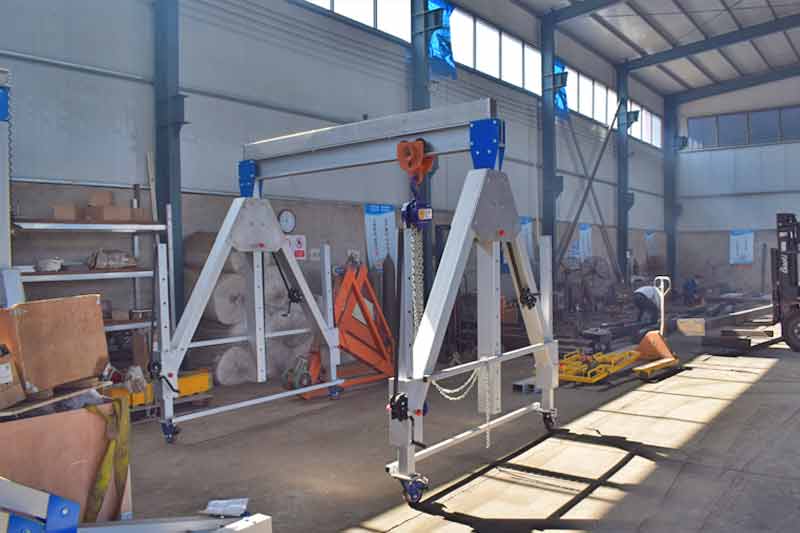
Aluminum Lightwight Portable Gantry Crane for Sale
Advantages of Lightweight Portable Gantry Cranes
- Mobility: One of the key advantages of these cranes is their ability to be moved effortlessly across different locations. This mobility ensures that the crane can be positioned precisely where it's needed, maximizing its utility.
- Quick Assembly: Lightweight portable gantry cranes are designed with userfriendliness in mind. They can be assembled and disassembled quickly, reducing downtime and increasing productivity.
- Versatility: These cranes can handle a variety of loads, making them suitable for diverse industries. Their adaptability ensures that they can be used in different scenarios without the need for extensive modifications.
- Space Efficiency: With their compact design, these cranes take up minimal space. This is particularly advantageous in workshops and warehouses where optimizing space is crucial for efficient operations.
Types of Lightweight Portable Gantry Cranes
- Adjustable Height Cranes: These cranes come with the flexibility to adjust their height, accommodating varying load sizes and workspace requirements. This feature adds an extra layer of versatility to the lifting process.
- Telescoping Cranes: Characterized by their extendable booms, telescoping cranes offer a greater reach. This is beneficial when dealing with materials or equipment situated in hardtoreach places.
- Aluminum Gantry Cranes: Known for their lightweight construction, aluminum gantry cranes are corrosionresistant and ideal for environments where weight is a critical factor. They are easy to handle without compromising on strength.
Understanding these types lays the foundation for selecting the most suitable crane for specific industrial needs. In the subsequent sections, we'll explore the features, applications, and considerations involved in the world of lightweight portable gantry cranes. Stay tuned for a deep dive into the structural components and lifting mechanisms that make these cranes indispensable tools in modern industrial settings.
Types of Lightweight Portable Gantry Crane - Adjustable Height, Fixed Height, and Portable
There are three main types of Lightweight Portable Gantry Cranes: adjustable height, fixed height, and portable.- Fixed Height Lightweight Portable Gantry Crane: This type of crane has a fixed height and cannot be adjusted. It is designed for use in applications where the load size and shape are consistent.
- Adjustable Width Lightweight Portable Gantry Crane: This type of crane has an adjustable width, allowing it to accommodate different load sizes. It is ideal for use in applications where the load size varies.
- Telescoping Lightweight Portable Gantry Crane: This type of crane has a telescoping boom that can be extended or retracted as needed. It is ideal for use in applications where the load needs to be lifted to different heights.
- Folding Lightweight Portable Gantry Crane: This type of crane can be folded up for easy storage and transport. It is ideal for use in applications where space is limited.
- Heavy-Duty Lightweight Portable Gantry Crane: This type of crane is designed to lift heavier loads than standard Lightweight Portable Gantry Cranes. It is ideal for use in industrial and manufacturing settings.
- Portable Lightweight Portable Gantry Crane: This type of crane is designed to be easily moved from one location to another. It is ideal for use in construction sites and other temporary work areas.
Overall, there are many different types of Lightweight Portable Gantry Cranes available, each with its own unique features and benefits. Businesses can choose the type of crane that best suits their needs based on factors such as load size, weight, and application requirements.
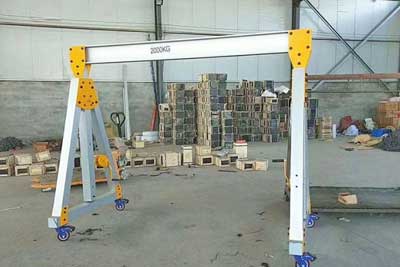
Movable Aluminum Gantry Crane With Rolling Castor
- Capacity up to 5 tons.
- Span up to 4 meters.
- Max. lifting height is no more than 5 meters
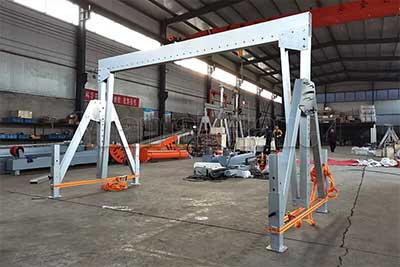
Selfstanding Stationery Aluminum Gantry Crane
- Capacity up to 2 tons.
- Span up to 4 meters.
- Max. lifting height is no more than 4 meters
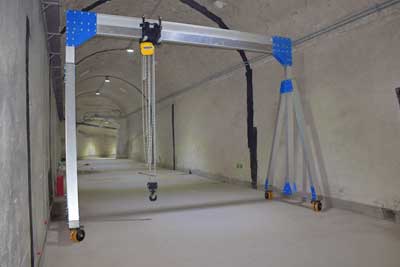
LT1: Aluminum Gantry Crane with Fixed Span and Height
- Capacity up to 5 tons.
- Span up to 4 meters.
- Max. height up to 5 meters
Get Fixed Span & Fixed Hight Aluminum Alloy Gantry Crane Price
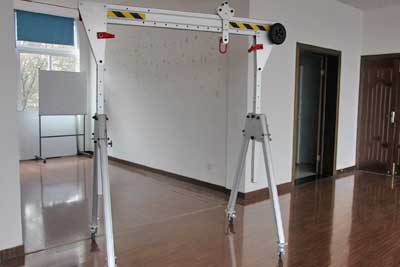
LT2:Foldable Aluminum Gantry Crane with Adjustable Span and Height
- Capacity up to 3 tons.
- Span up to 4 meters.
- Max. lifting height is no more than 6 meters
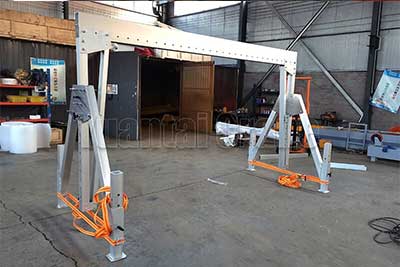
LT3: Fixed Aluminum Gantry Crane with Adjustable Span and Height
- Capacity up to 2 tons.
- Span up to 4 meters.
- Max. height up to 4 meters
Features of portable aluminum crane
- Lightweight and portable, with simple manual assembly on-site
- Assembly is as simple as'scissoring' and takes only 2-3 minutes.
- 36Swivel-locking castors are included as standard for easy positioning.
- All-terrain castors and uneven ground options are available, as well as simple manual height adjustment.
- Captive trolley that is ultra-secure.
- For shipping and storage, the small gantry can be packed flatly.
- Bolted structure, lateral beam, and leg bracing features provide total stability for any lifting challenge.
- Corrosion-resistant anodized finish that is easy to clean and suitable for clean room applications
PT-4 series of portable aluminum gantry crane with adjustable height design
Main parameters
- Model: PT-4
- Max Capacity: 10 tons
- Max Height :12 meters
- Max Span :12 meters
- Hoist Type: Electric hoist with motorized trolley
- Crane Travelling: Manual or motorized universal wheels
Featurs:
- Electric hoist with motorized trolley.
- Adjustable supporting legs, the lifting height of the portable gantry can be adjusted according to your requirement.
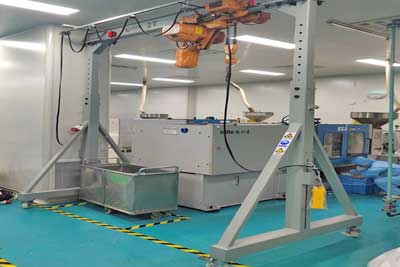 portable and adjustable gantry crane
portable and adjustable gantry craneModel: LT-1 Series of Aluminum gantry crane with foldable gantry design
Foldable Aluminum gantry crane are designed for transporting and lifting materials. Foldable aluminum gantry crane which is manufactured for the medium and small factory (company) daily production need. It applies to model manufacture and installing situation, automobile factories, producing department and other lifting occasions.
Main parameter of foldable gantry crane
- Load capacity of foldable gantry :0.5 ton - 5 tons
- Crane span of foldable gantry :2m - 8m or customized
- Lifting height of foldable gantry:1m to 8m or customized
- Hoist unit of foldable gantry:Motorized or manual
The foldable Aluminum gantry crane can move easily, disassemble and install quickly, cover little area. The structure design reasonably.
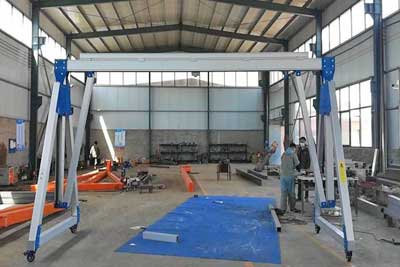 foldable gantry crane
foldable gantry crane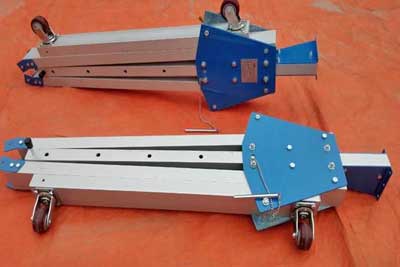 folded aluminum gantry crane, compact and easy for transportation and storage
folded aluminum gantry crane, compact and easy for transportation and storageModel: LT-2 series of fixed type aluminum gantry crane with adjustable span design
Main parameters
- Model: LT-2
- Max Capacity: 5 tons
- Max Height :8 meters
- Max Span :8 meters
- Hoist Type: Electrical or manual
- Crane Travelling: Fixed supporting leg, with no castor and can not move along wheels.
Features and Components
Now that we have laid the groundwork for understanding lightweight portable gantry cranes, let's delve into the essential features and components that make these lifting tools a cornerstone in industrial applications.
Structural Components
- Legs: The legs of a lightweight portable gantry crane form the foundational support structure. Typically made of durable materials such as steel or aluminum, these legs provide stability to the crane. Adjustable leg options are common, allowing for easy adaptation to different working environments and load sizes.
- Cross Beams: Connecting the legs at the top, cross beams serve as the horizontal structure that supports the load. The design and length of the cross beams are crucial considerations, ensuring they can accommodate the intended load capacity while maintaining structural integrity.
- Casters: The mobility of these cranes hinges on the quality of their casters. These wheels, mounted at the base of the legs, allow for smooth movement across the workshop or warehouse floor. Swivel casters enhance maneuverability, enabling precise positioning of the crane.
Lifting Mechanism
- Electric Hoists: Electric hoists are a popular choice for lightweight portable gantry cranes due to their efficiency and ease of use. Powered by electricity, these hoists provide smooth and controlled lifting, reducing manual effort. They are suitable for a wide range of lifting applications and can be equipped with features like variable speed control and overload protection.
- Manual Hoists: In scenarios where electricity is not readily available or for simpler tasks, manual hoists offer a costeffective solution. These hoists are operated by hand and are ideal for lighter loads. While they may require more physical effort, manual hoists are reliable and require minimal maintenance.
Mobility and Portability
- Wheel Options: The choice of wheels significantly influences the crane's mobility. Hard wheels are suitable for smooth surfaces, while softer wheels provide better traction on uneven floors. Some cranes feature lockable wheels to ensure stability during lifting operations.
- Folding Design: Portability is further enhanced by cranes with a folding design. This allows for compact storage and easy transportation between job sites. A folding gantry crane can be a valuable asset for businesses that require frequent relocation of their lifting equipment.
Understanding these structural and functional components is pivotal in selecting the right lightweight portable gantry crane for specific operational needs. In the next segment, we will guide you through the process of choosing the most appropriate crane based on weight capacity, height requirements, and material considerations. Stay tuned for practical insights that will empower you to make informed decisions when investing in this indispensable industrial equipment.
Choosing the Right Lightweight Portable Gantry Crane
Selecting the appropriate lightweight portable gantry crane is a critical decision that hinges on various factors. In this section, we'll guide you through the key considerations that will empower you to make an informed choice for your specific operational requirements.
Weight Capacity
The first and foremost consideration when choosing a lightweight portable gantry crane is its weight capacity. Understanding the maximum load the crane will handle is crucial to ensure safe and efficient lifting operations. Be sure to account for potential future needs and opt for a crane with a slightly higher weight capacity than your current requirements to accommodate any unforeseen changes in your operations.
Span and Height Requirements
The dimensions of your workspace play a pivotal role in determining the appropriate span and height of the gantry crane. Measure the distance between the legs (span) to ensure it aligns with the available space. Additionally, consider the vertical height requirements for lifting operations. Adjustable height cranes offer flexibility in adapting to different workspace configurations, making them suitable for diverse applications.
Material of Construction
The material of construction impacts the crane's durability, weight, and resistance to environmental factors. Steel gantry cranes provide robustness and durability, suitable for heavier loads and harsh working conditions. Aluminum gantry cranes, on the other hand, are lightweight, corrosionresistant, and ideal for applications where mobility is a primary concern. Evaluate the environmental conditions of your workspace to determine the most suitable material for your gantry crane.
Ease of Assembly and Disassembly
Efficiency in assembly and disassembly is a practical consideration, especially if the gantry crane needs to be relocated or stored frequently. Look for cranes with a straightforward assembly process that requires minimal tools. Features like quickrelease pins and snapin connectors can expedite the setup, minimizing downtime and enhancing overall productivity.
Safety Features
- Locking Mechanisms: Safety is paramount in any industrial setting. Ensure that the gantry crane is equipped with reliable locking mechanisms for both the legs and casters. This prevents unintended movements during lifting operations, providing stability and minimizing the risk of accidents.
- Overload Protection: To safeguard against overloading, opt for a gantry crane with builtin overload protection mechanisms. These features automatically shut down the lifting operation if the crane exceeds its weight capacity, preventing potential damage to the equipment and ensuring the safety of operators.
By carefully considering these factors, you can tailor your choice of a lightweight portable gantry crane to the specific demands of your industry. In the following section, we will explore the diverse applications of these cranes in workshops, warehouses, and facilities, shedding light on how they optimize material handling and improve overall operational efficiency. Stay tuned for insights into the practical implementation of lightweight portable gantry cranes in realworld industrial scenarios.
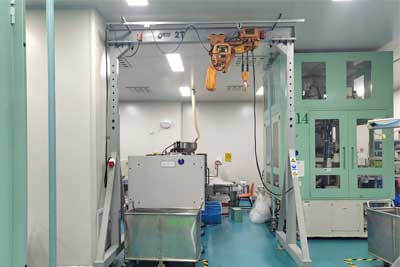 Adjustable Lightweight Portable Gantry Crane
Adjustable Lightweight Portable Gantry Crane Foldable Lightweight Portable Gantry Crane
Foldable Lightweight Portable Gantry Crane Fixed height portable Lightweight Portable Gantry Crane
Fixed height portable Lightweight Portable Gantry Crane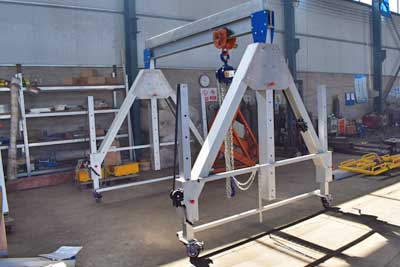 Height adjustable movable Lightweight Portable Gantry Crane
Height adjustable movable Lightweight Portable Gantry CraneTypical Applications in Workshops
Lightweight portable gantry cranes prove to be indispensable tools in various workshop environments, enhancing efficiency and streamlining material handling processes. Let's explore their typical applications in different workshop settings.
Automotive Workshops
- Engine Removal and Installation: Gantry cranes are frequently used in automotive workshops to lift and position engines during repairs or replacements. The adjustable height feature allows for precise maneuvering, ensuring a seamless integration with various vehicle models.
- Suspension System Maintenance: When working on the suspension systems of vehicles, gantry cranes provide the necessary lifting capabilities to elevate the car body, facilitating easy access to components for repairs or upgrades.
- Body Panel Installation: For tasks involving the placement of heavy body panels or components, gantry cranes assist in lifting and accurately positioning these elements, reducing the strain on automotive technicians.
Woodworking Shops
- Material Handling for Woodworking Machinery: Gantry cranes are utilized in woodworking shops to move heavy materials, such as timber or large wooden panels, around the workspace. This improves efficiency by reducing manual handling and minimizing the risk of injuries.
- Assisting with Large Woodworking Projects: Woodworkers often deal with sizable projects that require lifting and moving large workpieces. Gantry cranes provide the necessary support for these operations, ensuring precision in the assembly and construction of wooden structures.
Metal Fabrication Shops
- Loading and Unloading Materials: Gantry cranes excel in metal fabrication shops for loading and unloading raw materials and finished products. Their mobility allows for flexible positioning to streamline the workflow and optimize space utilization.
- Welding Operations: Gantry cranes play a crucial role in welding operations by assisting in the precise positioning of metal components. This ensures accuracy in welding processes and contributes to the overall quality of the fabricated products.
- Heavy Equipment Assembly: In metal fabrication, the assembly of heavy equipment requires careful handling. Gantry cranes provide the necessary lifting capabilities for positioning and joining large metal components with precision.
Maintenance and Repair Workshops
- Equipment Overhauls: In maintenance and repair workshops, gantry cranes are essential for lifting and overhauling heavy machinery and equipment. The adjustable height and mobility of these cranes facilitate efficient access to all parts of the machinery.
- Aircraft Maintenance: For facilities involved in aircraft maintenance, gantry cranes are used to lift and position airplane components for inspection, repairs, or replacements. Their versatility is crucial in handling the complex and varied structures of aircraft.
- Facility Upkeep and Repairs: Gantry cranes are valuable in workshops dedicated to facility maintenance. They aid in lifting and relocating heavy equipment, facilitating repairs and upkeep tasks with ease.
These diverse applications underscores the adaptability and versatility of lightweight portable gantry cranes in workshop environments. In the upcoming section, we will explore their usage in warehouses, shedding light on how these cranes contribute to efficient material handling and storage operations. Stay tuned for insights into the role of gantry cranes in optimizing warehouse workflows.
Typical Applications in Warehouses
In warehouses, efficient material handling is paramount for smooth operations. Lightweight portable gantry cranes prove to be invaluable in various warehouse applications, enhancing productivity and optimizing storage processes.
Material Handling and Storage
- Palletized Goods Handling: Gantry cranes facilitate the lifting and movement of palletized goods, streamlining the process of organizing and accessing stored materials.
- Loading and Unloading Shelves: These cranes aid in loading and unloading materials onto warehouse shelves, ensuring a systematic arrangement of goods for easy retrieval.
Loading and Unloading Trucks
- Container and Pallet Loading: Gantry cranes play a crucial role in loading and unloading trucks with efficiency, especially when dealing with heavy or awkwardly shaped items.
- Freight Handling: Handling freight and cargo becomes more manageable with the use of gantry cranes, improving the speed and accuracy of loading and unloading operations.
Assembly and Packaging Areas
- Product Assembly: Gantry cranes assist in lifting and positioning components for assembly, contributing to a streamlined and efficient production process.
- Packaging Operations: For warehouses involved in packaging, gantry cranes are instrumental in handling bulk materials and assisting in the packaging of finished goods.
Inventory Management
- Stock Replenishment: Gantry cranes facilitate the movement of goods for stock replenishment, ensuring that inventory levels are maintained efficiently.
- Inventory Sorting and Organization: These cranes contribute to the organization of inventory by aiding in the movement of items within the warehouse, making it easier to access and manage stock.
Typical Applications in Facilities
The versatility of lightweight portable gantry cranes extends beyond traditional workshops and warehouses, making them indispensable in various facilities. In this section, we'll explore how these cranes find applications in different industrial settings, contributing to efficiency and safety.
Event and Exhibition Spaces
- Stage Setup and Rigging: Gantry cranes are utilized in event spaces for the assembly and rigging of stages, lighting, and audio equipment. Their portability allows for quick and precise positioning, ensuring a smooth setup for concerts, exhibitions, and other events.
- Booth Construction: During exhibitions, gantry cranes aid in the construction of elaborate booths and displays, enabling exhibitors to efficiently handle heavy elements and create visually impactful presentations.
Construction Sites
- Material Transportation: Gantry cranes play a vital role in transporting construction materials within the site, facilitating the movement of steel beams, concrete blocks, and other heavy components.
- Structural Assembly: Construction projects often involve the assembly of large structural elements. Gantry cranes assist in positioning and securing these components during the construction process.
Shipbuilding Yards
- Hull and Deck Assembly: Lightweight portable gantry cranes are used in shipbuilding yards for the assembly of ship hulls and decks. Their flexibility allows for precise positioning during the construction of vessels.
- Engine and Equipment Installation: These cranes aid in the installation of ship engines, heavy equipment, and components, ensuring efficient workflows in shipyards.
Aerospace Manufacturing Facilities
- Aircraft Component Handling: Gantry cranes are integral to the aerospace industry, assisting in the handling and assembly of aircraft components with precision and safety.
- Tool and Equipment Positioning: In aerospace manufacturing, gantry cranes are utilized to position specialized tools and equipment required for the intricate assembly of aircraft parts.
The adaptability of lightweight portable gantry cranes across such diverse facilities showcases their versatility and highlights their significance in modern industrial operations. In the final section of this comprehensive guide, we will delve into safety guidelines, installation procedures, and maintenance practices, ensuring that users can harness the full potential of these cranes while prioritizing safety and longevity. Stay tuned for practical insights that will guide you through the safe and efficient use of lightweight portable gantry cranes in your industrial endeavors.
Safety Guidelines
While lightweight portable gantry cranes are powerful tools that enhance efficiency in various industrial applications, their safe operation is paramount. In this section, we'll explore key safety guidelines that ensure the wellbeing of operators and the longevity of the equipment.
Operator Training
- Comprehensive Training Programs: Before operating a lightweight portable gantry crane, operators should undergo comprehensive training programs. Training should cover crane assembly, disassembly, lifting procedures, and emergency protocols.
- Certification and Licensing: Operators must be certified and licensed to operate the specific type of gantry crane they are handling. Regular refresher courses should be provided to keep operators updated on best practices and safety measures.
- Familiarity with Controls: Operators should be familiar with the controls of the crane, including emergency stop buttons, directional controls, and any additional features specific to the model. This knowledge ensures precise and safe crane operation.
Load Capacity Limits
- Strict Adherence to Weight Capacities: Always adhere to the specified weight capacities outlined by the manufacturer. Exceeding these limits can compromise the structural integrity of the crane and pose serious safety risks.
- Consider Dynamic Loading: Be mindful of dynamic loading, which occurs when the load is in motion. The crane's weight capacity should account for both the static and dynamic loads to ensure safe lifting operations.
Inspection and Maintenance
- Regular Inspection Routine: Establish a regular inspection routine for the gantry crane. Inspect structural components, casters, and lifting mechanisms for signs of wear, damage, or corrosion. Address any issues promptly.
- Lubrication and Wear Prevention: Ensure proper lubrication of moving parts to prevent frictionrelated wear. Lubrication schedules should be in accordance with the manufacturer's recommendations.
- Professional Maintenance Checks: Periodic professional inspections by qualified technicians are crucial. These checks should include a thorough examination of electrical components, loadbearing elements, and safety features.
Emergency Procedures
- Emergency Stop Procedures: Operators should be trained to engage emergency stop procedures in case of any malfunction or unexpected circumstances. Emergency stop buttons should be easily accessible.
- Evacuation Plans: Establish clear evacuation plans for the workspace in case of emergencies. Ensure all personnel are familiar with escape routes and emergency assembly points.
- Communication Protocols: Implement effective communication protocols, including signals between operators and spotters. Clear communication enhances coordination and reduces the risk of accidents.
- Emergency Response Training: Conduct regular emergency response drills to ensure that all personnel are prepared to handle unforeseen situations. This includes scenarios such as power failures, equipment malfunctions, or natural disasters.
By prioritizing operator training, respecting load capacity limits, conducting regular inspections, and implementing robust emergency procedures, organizations can create a safer working environment when utilizing lightweight portable gantry cranes. In the final section, we will guide you through the installation and assembly process, as well as provide insights into maintenance practices to prolong the lifespan of your gantry crane. Stay tuned for practical tips that will help you harness the full potential of this essential industrial equipment.
Installation and Assembly
Proper installation and assembly are fundamental to ensuring the safe and efficient operation of lightweight portable gantry cranes. In this section, we'll provide a stepbystep guide, outline the necessary tools, and emphasize precautions and safety measures to be taken during the assembly process.
StepbyStep Assembly Guide
- Site Preparation: Choose a level and stable surface for assembly. Ensure the area is clear of obstacles and provides sufficient space for the fully assembled crane.
- Positioning the Legs: Unfold the gantry crane legs and position them at the desired location. Securely lock the legs in place, following the manufacturer's guidelines.
- Attaching Cross Beams: Attach the cross beams to the tops of the legs, ensuring proper alignment. Confirm that all connections are securely fastened using the provided hardware.
- Installing Casters: Attach casters to the bottom of each leg to enable smooth mobility. Ensure that the casters are securely locked to prevent unintended movement during operation.
- Mounting the Hoist: If equipped with an electric or manual hoist, follow the manufacturer's instructions for mounting and securing the hoist to the cross beams.
- Adjusting Height (if applicable): If the gantry crane has adjustable height features, set it to the desired level according to the specific lifting requirements.
- Securing Bolts and Fasteners: Doublecheck all bolts and fasteners to ensure they are tightened securely. Periodically inspect and tighten connections during the crane's lifespan.
- Conducting a Functionality Check: Test the crane's mobility, ensuring that it moves smoothly and that the casters operate properly. If equipped with a hoist, test the lifting and lowering functions to confirm proper operation.
Tools Required
The tools required for the assembly of a lightweight portable gantry crane may vary depending on the specific model. However, a standard set of tools typically includes:
Wrenches (adjustable and socket wrenches)
Allen wrenches
Screwdrivers
Hammer
Tape measure
Level
Always refer to the manufacturer's assembly instructions for the specific tools recommended for your gantry crane model.
Precautions and Safety Measures
- Read the Manual: Familiarize yourself with the manufacturer's assembly instructions and safety guidelines provided in the manual before initiating the assembly process.
- Teamwork: Assembly is often a twoperson job. Work with a partner to ensure safe and efficient handling of components.
- Protective Gear: Wear appropriate personal protective equipment, including gloves and safety glasses, during the assembly process.
- Stability Check: Regularly check the stability of the crane during assembly, especially after completing each step. Ensure all components are properly aligned and securely fastened.
- Adhere to Weight Limits: Avoid exceeding the weight limits specified by the manufacturer during assembly and operation. Overloading the crane can compromise its structural integrity.
- Weather Considerations: If assembling the crane outdoors, be mindful of weather conditions. Avoid assembly in strong winds or adverse weather that may impact stability.
- Emergency Stop Procedures: Ensure all operators are aware of emergency stop procedures and can quickly halt operations if necessary.
By following a systematic assembly guide, using the appropriate tools, and adhering to precautions and safety measures, the installation of a lightweight portable gantry crane can be a smooth and secure process. In the final section of this comprehensive guide, we will explore maintenance practices to keep your gantry crane in optimal condition for longterm use. Stay tuned for practical insights that will help you extend the lifespan of your industrial equipment.
Maintenance and Troubleshooting
Regular maintenance is key to ensuring the longevity and optimal performance of lightweight portable gantry cranes. In this section, we will guide you through establishing a regular inspection schedule, proper lubrication and cleaning procedures, and common issues that may arise, along with their solutions.
Regular Inspection Schedule
- Daily Inspections: Check for any visible damage, loose bolts, or misalignment before each use. Inspect the casters for smooth rotation and secure attachment.
- Weekly Inspections: Examine all structural components for signs of wear, cracks, or corrosion. Verify that locking mechanisms on legs and casters are functioning correctly.
- Monthly Inspections: Conduct a thorough inspection of the hoisting mechanism, checking for any abnormalities in cable or chain operation. Inspect electrical components if the crane is equipped with an electric hoist.
- Annual Professional Inspection: Arrange for a professional inspection by qualified technicians to ensure compliance with safety standards. This inspection should include load testing to verify the crane's weight capacity.
Lubrication and Cleaning
- Lubrication: Follow the manufacturer's recommendations for lubricating moving parts, including joints, pulleys, and bearings. Use highquality lubricants suitable for the specific components.
- Cleaning: Regularly clean the crane, especially if used in dusty or corrosive environments. Remove debris and foreign particles that may affect the smooth operation of moving parts.
- Electrical Component Care: If the crane has electric components, ensure that electrical connections are clean and free of corrosion. Periodically inspect the electrical wiring for any signs of wear or damage.
Common Issues and Solutions
- Caster Issues: Issue: Uneven movement or difficulty in maneuvering. Solution: Inspect and clean casters regularly. Replace any damaged or wornout casters.
- Hoisting Mechanism Problems: Issue: Irregular lifting or lowering. Solution: Check for any obstructions in the hoist mechanism. Lubricate the hoist according to the manufacturer's recommendations. If issues persist, consult with a professional technician.
- Structural Concerns: Issue: Cracks, misalignment, or visible damage to structural components. Solution: Cease use immediately and consult with a qualified technician for a thorough inspection. Do not attempt to repair structural damage without professional guidance.
- Electrical Malfunctions: Issue: Power fluctuations or failure in the electric hoist. Solution: Check the power source and electrical connections. If issues persist, consult with an electrician or the crane manufacturer.
- Overload Situations: Issue: Crane overloading and triggering overload protection. Solution: Review the weight capacity limits and ensure the load being lifted is within the specified range. If the issue persists, consult with the manufacturer or a professional technician.
Implementing a proactive maintenance schedule and promptly addressing any issues that arise will contribute to the safe and efficient operation of your lightweight portable gantry crane. In the concluding section of this comprehensive guide, we will recap the benefits of these cranes, offer final considerations for potential buyers, and provide contact information for reputable suppliers. Stay tuned for a summary that encapsulates the essence of this guide and serves as a valuable reference for your industrial lifting needs.
Conclusion
As we conclude this comprehensive guide on lightweight portable gantry cranes, let's recap the benefits they offer, provide essential considerations for potential buyers, and offer contact information for reputable suppliers.
- Versatility and Mobility: Lightweight portable gantry cranes offer unparalleled versatility, easily adapting to various industrial applications. Their mobility allows for precise positioning, enhancing efficiency in material handling and lifting operations.
- Quick Assembly and Disassembly: These cranes are designed for quick setup and disassembly, minimizing downtime and increasing overall productivity.
- Space Efficiency: With a compact design, lightweight portable gantry cranes optimize space utilization in workshops, warehouses, and facilities.
- Ease of Operation: Whether equipped with electric or manual hoists, these cranes are userfriendly, making them accessible for operators of different skill levels.
- Safety Features: Features such as locking mechanisms and overload protection prioritize safety during lifting operations.
Final Considerations for Purchase
- Define Your Requirements: Clearly outline your specific lifting needs, including weight capacity, span, and height requirements.
- Choose the Right Type: Select the type of gantry crane that best suits your applications, considering adjustable height, telescoping features, or aluminum construction.
- Review Safety Features: Prioritize safety features such as locking mechanisms and overload protection to ensure a secure working environment.
- Consider Material and Construction: Evaluate the environmental conditions of your workspace to determine whether steel or aluminum construction is more suitable.
- Factor in Portability: If frequent relocation is required, consider a crane with a folding design for enhanced portability.




